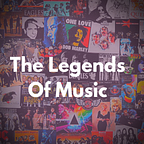The Story of “Light My Fire” by The Doors
Never before in the history of the #MusicIndustry has a simple phrase such as “Come on baby, light my fire” had such an important effect on the music industry and the minds of millions of listener’s all around the world. Thanks to this phrase the attention of all the right people was caught and this called for a rebellious revolution in the music industry where Psychedelic Music was now at the forefront of #RockNRoll. “Light My Fire” can possibly be considered to be the song that brings about the best in the band as frontman #JimMorrison’s flamboyant antics are on display for the whole world to see, which is accompanied by the musical virtuosity of the trio of musicians that transcend #PsychedelicRock a whole new level.
51 years after it’s release, the song still serves as the prime example on the musical heights the band could elevate to. Originally conceived by guitarist Robby Krieger who’s finger-style approach to playing the guitar, bottleneck slide & broad music taste became the cornerstone of the song-writing that took place in the band. The genesis for the song came into play when vocalist “Jim Morrison” ordered the rest of the band to take up the share of song-writing and put out a message that’s “Universal” and wouldn’t go out of style in the next year or two. Krieger responded positively to the idea and considered using the four elements ‘Earth’, ‘Water’, ‘Fire’ and ‘Air as inspiration. Ultimately he settled on just ‘fire’ due to his love for The Rolling Stones song “Play With Fire”.
Origins of The Song
Robby later explained that he wasn’t aware from where he came up with the iconic phrase “Come on baby, light my fire”, but stuck with it because no one had said those words until that point in time. His original intention for the song was to write the song as a folk-rock song, while deciding to include every chord he knew at the time into this song. The reason behind this is that most Rock N Roll songs in that era was born out 3–4 chords. So the iconic intro was written taking into account all the sharps and flat chord progressions since no one uses them in Rock N Roll. The solo of the song was written using the chords ‘Aminor’ and ‘Bminor’, which were modelled after “My Favourite Things” by John Coltrane a respected Jazz artist. It’s also worth noting that as a flamenco-trained guitarist Robbie was capable of creating Eastern inspired Sitar sounds with his Gibson SG. This instantly should show you his musical diversity and why his knowledge was such an important part in the songwriting process of the band.
From a lyrical perspective, the song features some stellar poetry from a confident #JimMorrison who uses the chorus and song strucure provided by Robbie Krieger to put forward some blatantly sexual lyrics to appeal to the growing psychedelic audience. As time has progressed, the second verse of the song has grown in recognition since it showcases Jim Morrison’s ability to pen poetry at it’s finest. Adding verses such as “The time to hesitate is through”, “No time to wallow in the mire”, “Try now we can only lose”, and “Our love become a funeral pyre” definitely gives the song a much more depth and meaning. This now plays heavily on themes of ‘Love’, ‘Sex’, & ‘Drugs’, which definitely play well as the single was released as the psychedelic era was in it’s prime.
Instrumentation
While the studio recording of the band is quite commendable, the band’s real musical accomplished would be successfully playing this song live as each members musical virtuosity is on display for the world to see. The instrumentation symbolically represents the trio’s ability to push each other into some remarkably intense and emotional interaction. It’s definitely worthwhile for the listener to pay attention to their improvisational skills as they flawlessly support Morrison’s non-verbal and inaudible cues. Between the verses, lie some of the most mesmerising psychedelic solo’s, which consists of Ray Manzarek melodically building on his piano lead as the space opens up in John Densmore’s fluid jazz and Eastern-influenced drumming. As this progresses, the path is waved for Robby Krieger to follow suit and put down some stellar fretwork that changes the direction of his solo that reunites the band for the final verse and chorus.
Legacy of the song
Five decades after it’s release “Light My Fire” continues to showcase just how mesmerising “The Doors” were to an entire generation of fans and musicians. The song is now become the identity of the ’60s psychedelic and sexual revolutions. It has also seen it’s fair share of covers from high-profile artists like Shirley Bassey.
